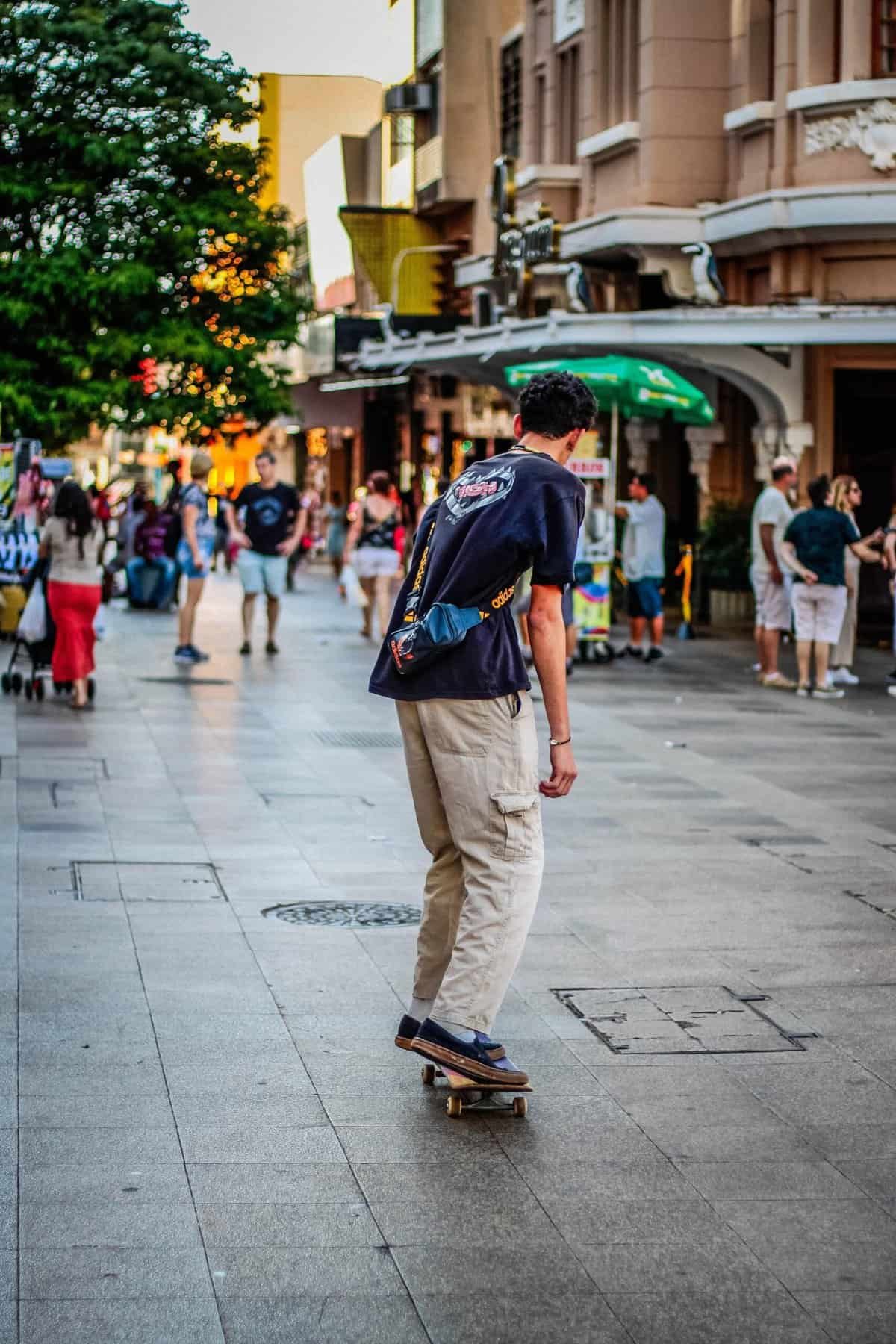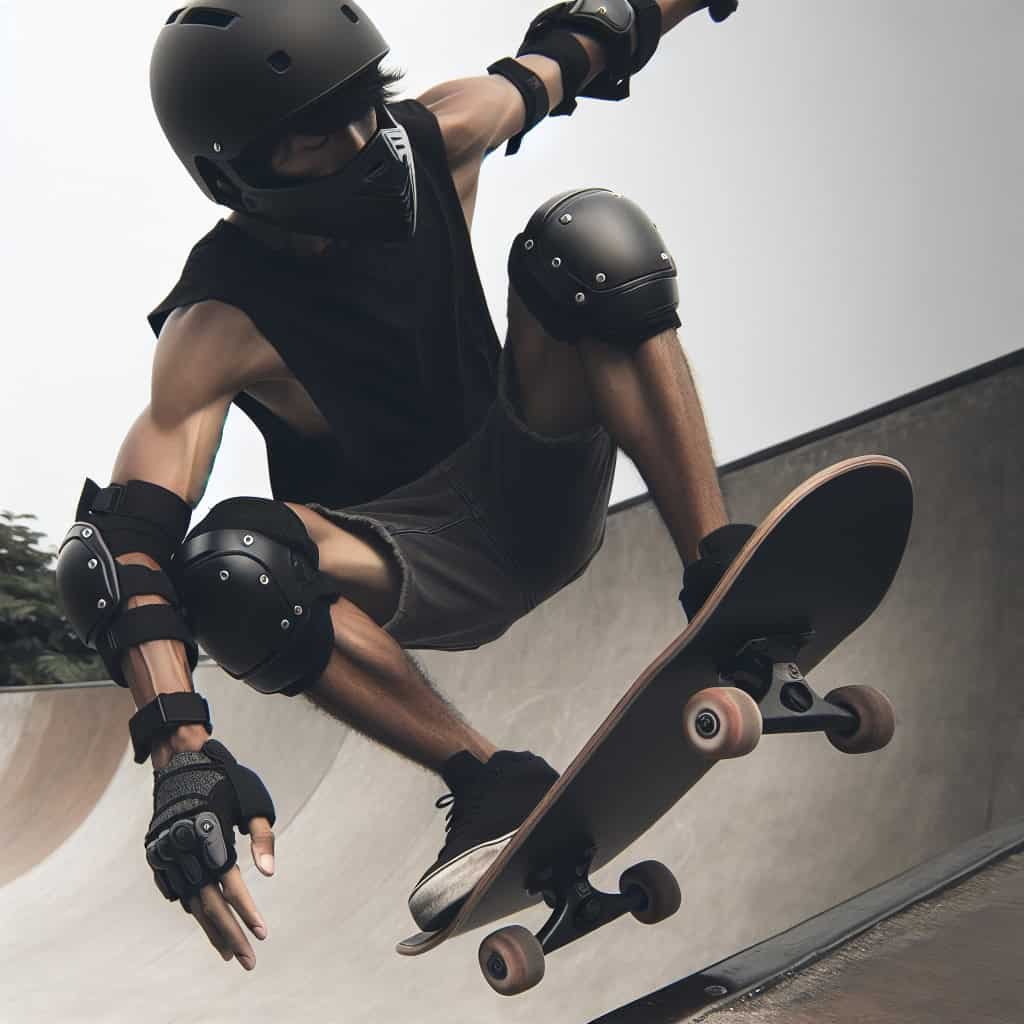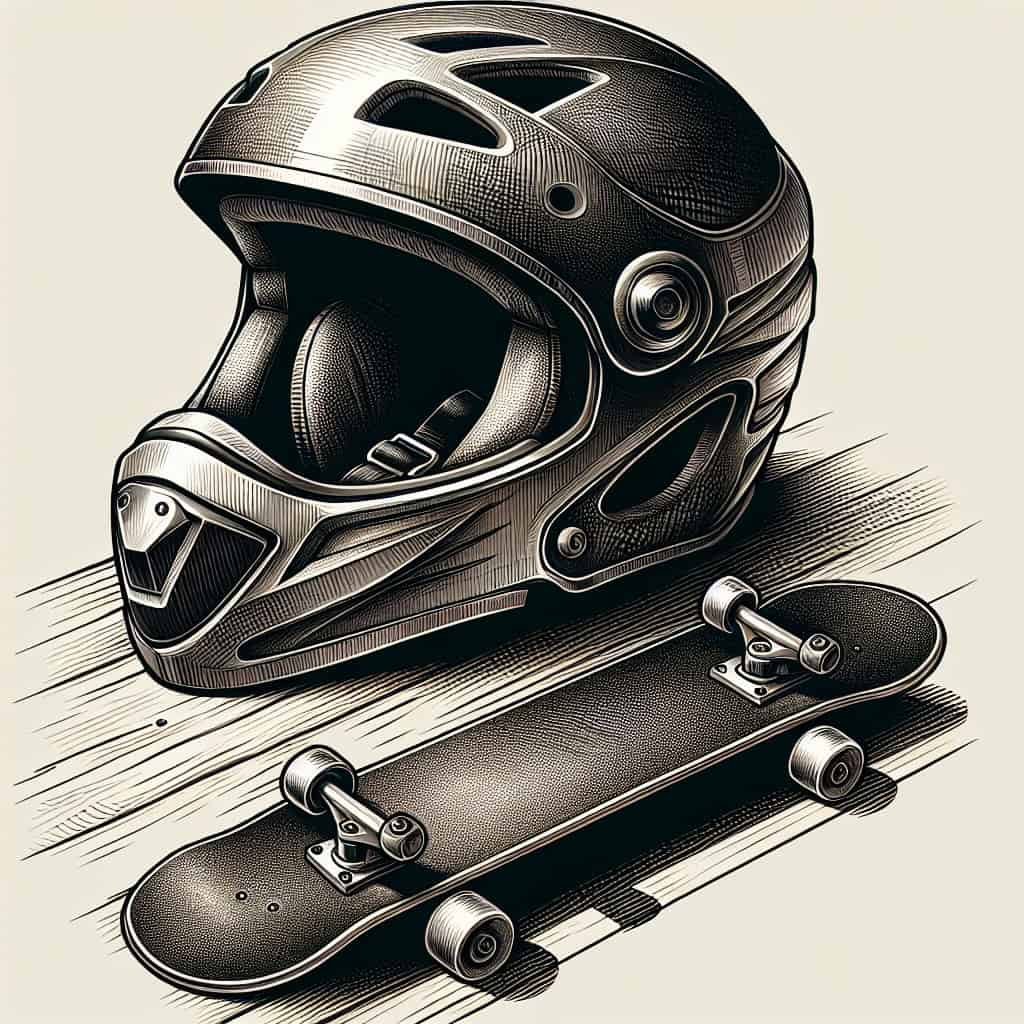Skateboarding is an exhilarating sport that offers a unique blend of freedom and adrenaline, but it’s crucial to prioritize safety when hitting the pavement. To ensure a smooth ride while minimizing the risk of injuries, equipping yourself with essential safety gear is absolutely essential. From helmets to knee pads and wrist guards, this article will provide you with an in-depth guide on the must-have items that will keep you safe and sound on your next skateboarding adventure. So gear up and get ready to ride with confidence! Skateboarding is a thrilling and exciting sport that requires skill, balance, and control. Whether you’re a newcomer or a seasoned pro, it’s important to prioritize safety while enjoying this exhilarating activity. Wearing the right safety gear is crucial to protect yourself from injuries that can occur during skateboarding. In this comprehensive guide, we will explore the essential safety gear items for skateboarding to ensure that you have the safest and most enjoyable riding experience possible.
Helmet
Choosing the right helmet
When it comes to skateboarding, wearing a helmet is non-negotiable. Your head is one of the most vulnerable areas and protecting it should be your top priority. When choosing a helmet, make sure it meets safety standards such as the ASTM F1492 or CPSC certification. Look for a helmet that fits securely on your head and doesn’t wobble or slide around. Comfort is essential, so opt for helmets with adequate padding and adjustable straps. Consider the ventilation system to ensure proper airflow, preventing overheating while riding.
Helmet sizing and fit
To determine the right helmet size for your head, measure the circumference just above your eyebrows and ears. Refer to the manufacturer’s sizing chart to find the ideal size that matches your measurements. Try on different sizes to find the one that provides a snug yet comfortable fit. The helmet should sit level on your head, with the front edge positioned one or two finger-widths above your eyebrows. Secure the chin strap tightly to prevent the helmet from shifting during impact.
Types of helmets available
There are various types of helmets available for skateboarding, each with its own unique features and designs. Traditional skate helmets are the most common, providing full coverage and protection. They typically feature a hard shell made of durable materials like ABS plastic and a soft inner foam liner to absorb impact. Other options include multi-sport helmets, which can be used for different activities like biking or rollerblading, and full-face helmets that provide additional protection for downhill or freeride skateboarding. Choose a helmet that suits your specific needs and preferences.
Knee Pads
Importance of knee pads
Skateboarding involves a lot of tricks, jumps, and maneuvers. During these high-impact movements, your knees are at risk of injury from falls or collisions. Knee pads are essential safety gear that protect your knee joints, ligaments, and kneecaps from impact and abrasions. They act as a cushion and provide a barrier between your knees and the hard concrete. By wearing knee pads, you significantly reduce the risk of serious injuries such as fractures or dislocations.
Types of knee pads
When shopping for knee pads, you’ll come across a variety of options, each designed for different levels of protection and flexibility. Basic knee pads are lightweight and provide minimal padding, suitable for casual skateboarders or beginners. For more advanced riders or those attempting high-intensity tricks, consider knee pads with thick padding and hard outer shells for maximum protection. Some knee pads even come with additional features like articulated designs for improved mobility and straps for secure and customizable fits.
Proper way to wear knee pads
To ensure maximum effectiveness, it’s crucial to wear knee pads correctly. Start by selecting the appropriate size for your knees, as wearing improperly fitted pads may hinder your movements or become too loose during skateboarding. Position the pad over your knee, making sure it covers the entire area, including the sides and front. The pad should be snug but not too tight, allowing for proper blood circulation. Adjust the straps or closures to secure the pads in place, ensuring they do not shift or slide during skateboarding.

Elbow Pads
Why elbow pads are important
Similar to knee pads, elbow pads play a vital role in protecting your joints while skateboarding. Falls and collisions can cause severe injuries to the delicate bones and ligaments in your elbows, leading to fractures or dislocations. Elbow pads act as a shield, absorbing impact and reducing the risk of such injuries. By wearing elbow pads, you can confidently tackle challenging maneuvers and tricks without worrying about the consequences of a fall.
Different styles of elbow pads
Elbow pads come in various styles to cater to different skateboarding needs and preferences. Standard elbow pads feature a hard outer shell and inner foam padding, providing both protection and comfort. These pads are suitable for general skateboarding or learning basic tricks. For more advanced riders or those engaged in aggressive skateboarding, consider heavy-duty elbow pads with reinforced caps and additional padding. These pads are designed to withstand high-impact falls and provide maximum protection.
How to wear elbow pads correctly
Properly wearing elbow pads is essential to ensure optimal safety and comfort. Start by selecting the right size for your elbows, ensuring a snug fit without restricting movement. Place the pads over your elbows, making sure the protective caps cover the entire joint area. Tighten the straps or closures to secure the pads in place, ensuring they stay in position during skateboarding. It’s important to regularly check the fit and adjust the straps as needed to maintain a secure and comfortable fit.
Wrist Guards
The role of wrist guards in skateboarding
As you progress in skateboarding and attempt more advanced tricks, the likelihood of falling and injuring your wrists increases. Wrist guards are crucial safety gear items that protect your wrists from fractures, sprains, and other painful injuries. These guards are designed to stabilize your wrists, preventing excessive movement during falls and absorbing impact to reduce the risk of serious injuries. By wearing wrist guards, you can confidently push your skateboarding skills to new levels while minimizing the chances of wrist-related accidents.
Different types of wrist guards
There are several types of wrist guards available, each offering various levels of protection and flexibility. Basic wrist guards consist of a rigid splint and cushioning materials, providing essential support and impact resistance. They are suitable for beginner skateboarders or those who prefer minimal gear. Advanced wrist guards feature additional protective elements like reinforced splints, adjustable closures, and breathable fabrics for enhanced comfort during extended skateboarding sessions. Choose wrist guards that fit your needs and riding style.
Correct positioning and wearing of wrist guards
To ensure proper protection, it’s crucial to wear wrist guards correctly. Start by selecting the appropriate size for your wrists, ensuring a snug but not constricting fit. Position the guards over your wrists, making sure the splint is centered and aligns with the back of your hand. Fasten the closures securely but not too tight, as excessive tightness may restrict blood circulation. Ensure the guards stay in place and do not shift during skateboarding, allowing for complete wrist support and freedom of movement.

Shin Guards
How shin guards protect skateboarders
When performing tricks or riding on ramps, skateboarders often expose their lower legs to potential impacts and injuries. Shin guards provide necessary protection to the front of your shins, guarding against painful scrapes, bruises, and even fractures. By wearing shin guards, you can confidently tackle challenging maneuvers and obstacles without worrying about the constant risk of leg-related injuries.
Types of shin guards available
Shin guards come in various sizes and styles, offering different levels of protection and flexibility. Basic shin guards are lightweight and provide minimal coverage, suitable for casual skateboarders or those learning basic tricks. For more advanced riders or those engaging in aggressive skateboarding, consider shin guards with extended coverage and additional padding. These guards are designed to withstand hard impacts, offering maximum protection to your shins.
Tips for wearing shin guards effectively
To ensure optimal protection and comfort, it’s essential to wear shin guards correctly. Select the appropriate size for your shins and make sure the guards provide coverage from just below the knee down to the top of your ankle. Position the shin guards over your shins, ensuring they sit snugly and cover the entire frontal area. Fasten the straps or closures securely but not excessively tight, as proper blood circulation is essential. Double-check that the guards do not move or slide during skateboarding, allowing for complete protection while maintaining mobility.
Ankle Braces
The significance of ankle braces in skateboarding
Ankles are vulnerable to sprains and strains, especially during landing tricks or when riding on uneven surfaces. Ankle braces are essential safety gear items that provide necessary support and stability to prevent such injuries. By wearing ankle braces, you can minimize the risk of ankle-related accidents and confidently focus on improving your skateboarding skills.
Different styles of ankle braces
Ankle braces are available in various styles and designs, catering to different levels of support and flexibility. Basic ankle braces provide moderate support and are suitable for skateboarders who prefer minimal gear. They incorporate straps and adjustable closures to secure the ankle and limit excessive movements. Advanced ankle braces feature reinforced supports, additional cushioning, and adjustable straps for custom fits. These braces are ideal for more aggressive riders or those with a history of ankle injuries.
Proper way to wear ankle braces
To ensure proper support and protection, it’s important to wear ankle braces correctly. Start by selecting the appropriate size and type of brace for your ankles. Position the brace over your ankle, ensuring the supports are aligned with the sides and front of your ankle joint. Fasten the straps or closures securely but not too tight, as comfort and proper blood circulation are essential. Check the fit regularly and adjust the straps as needed to maintain a secure and comfortable fit.

Mouthguard
Why wearing a mouthguard is crucial for skateboarding
Skateboarding involves high-speed movements and the potential for falls or collisions. Protecting your teeth, gums, and jaw is vital, making mouthguards a crucial safety gear item. Mouthguards provide a layer of cushioning and shock absorption, minimizing the risk of dental injuries and jaw fractures. By wearing a mouthguard, you can confidently tackle any obstacles or tricks without worrying about the potential consequences of an accident.
Different types of mouthguards
Mouthguards come in various types, each offering different levels of protection and comfort. Stock mouthguards are pre-formed and ready-to-wear, although they may not provide the best fit or comfort. Boil-and-bite mouthguards allow for a customizable fit by softening the material in hot water and molding it to your teeth. These mouthguards offer improved comfort and protection. Custom-fitted mouthguards, created by dental professionals, provide the highest level of fit, comfort, and protection. They are individually designed to suit your mouth and specific needs.
Proper mouthguard maintenance
To ensure the longevity and effectiveness of your mouthguard, proper maintenance is essential. Rinse the mouthguard with clean water before and after each use to remove any debris or bacteria. Avoid exposing the mouthguard to extreme heat or direct sunlight, as it may warp or lose its shape. Store the mouthguard in a clean, dry case and avoid placing heavy objects on top of it. Regularly inspect the mouthguard for signs of wear or damage and replace it as needed to maintain optimal protection.
Protective Gloves
Importance of protective gloves in skateboarding
Skateboarding involves using your hands for balance, gripping the board, and protecting yourself during falls. Finger and hand injuries are common in skateboarding, making protective gloves a vital safety gear item. Gloves offer padding and abrasion resistance, protecting your palms, fingers, and knuckles from impact, scrapes, and friction burns. By wearing protective gloves, you can confidently ride, perform tricks, and slide on any surface without worrying about hand-related injuries.
Types of gloves suitable for skateboarding
When it comes to skateboarding gloves, there are various styles and designs to choose from, each offering different levels of protection and functionality. Light-duty gloves are suitable for casual skateboarders or those who prefer minimal gear. They provide basic palm padding and breathable materials for comfort. Heavy-duty gloves feature additional protective elements like reinforced knuckle guards, impact-resistant padding, and durable materials to withstand intense use. These gloves are ideal for aggressive riders or those engaged in high-impact skateboarding activities.
Features to consider when choosing gloves
When selecting skateboarding gloves, consider the features that best suit your needs and preferences. Look for gloves with sturdy materials that provide durability and protection against abrasions. Breathable fabrics and ventilation systems are essential to prevent your hands from overheating and sweating excessively while riding. Adjustable straps or closures ensure a secure and customizable fit. Choose gloves with reinforced areas like the palms, knuckles, and fingertips for enhanced protection during falls or slides.

High-Visibility Clothing
Why high-visibility clothing is important for skateboarders
Skateboarding often takes place in outdoor environments, where visibility can be limited, especially during low-light conditions or in busy urban areas. High-visibility clothing is crucial to ensure that you are easily spotted by motorists, cyclists, and pedestrians, minimizing the risk of accidents or collisions. By wearing high-visibility clothing, you significantly enhance your safety while skateboarding, making it easier for others to see and anticipate your movements.
Recommended colors for visibility
When it comes to high-visibility clothing, certain colors are more effective at catching attention than others. Fluorescent colors like neon yellow, green, or orange are highly visible in daylight and stand out against the surrounding environment. These colors create a contrast that attracts immediate attention, making you more noticeable to others. Reflective materials and trims are also beneficial, especially in low-light situations. They reflect light from car headlights or street lamps, making you visible even when natural lighting is limited.
Reflective gear and accessories
To further enhance your visibility while skateboarding, consider incorporating reflective gear and accessories into your outfit. Reflective vests, armbands, or ankle bands provide an extra layer of visibility, especially when paired with high-visibility clothing. Reflective stickers or decals on your helmet, skateboard, or backpack create additional points of reflection, making you more noticeable from multiple angles. These accessories are easy to use and can significantly improve your overall visibility, ensuring a safer skateboarding experience.
Safety Tips
General safety tips for skateboarders
While having the right safety gear is essential, it’s equally important to practice general safety measures while skateboarding. Here are some crucial tips to keep in mind:
- Always wear your safety gear, including a helmet, knee pads, elbow pads, wrist guards, and any other protective equipment you deem necessary.
- Ensure your safety gear fits properly and is adjusted correctly before each skateboarding session.
- Skate in areas specifically designated for skateboarding to minimize the risk of collisions with pedestrians or vehicles.
- Be aware of your surroundings at all times and anticipate potential hazards such as cracks, potholes, or uneven surfaces.
- Avoid skateboarding in adverse weather conditions like rain or snow, as they can make surfaces slippery and increase the risk of accidents.
- Practice and master basic skateboarding techniques before attempting more advanced tricks or maneuvers.
- Communicate with fellow skateboarders and pedestrians to ensure everyone is aware of each other’s presence on the skating surface.
- Avoid distractions such as using your phone or listening to music while skateboarding, as they can impair your focus and reaction time.
Importance of learning and practicing skateboarding techniques
Skateboarding requires skill, balance, and coordination. Learning and practicing proper skateboarding techniques not only improves your overall performance but also minimizes the risk of accidents and injuries. Start with the basics, such as balance and pushing off, before progressing to tricks and maneuvers. Take the time to master each skill step by step, ensuring you have a solid foundation before moving on to more advanced techniques. Learning from experienced skateboarders or enrolling in skateboarding lessons can further enhance your skateboard skills and safety.
Awareness of surroundings while skateboarding
Maintaining awareness of your surroundings is crucial for your safety and the safety of others while skateboarding. Always be alert and vigilant, constantly scanning the area for potential hazards, pedestrians, or other skateboarders. Pay attention to traffic and abide by all road rules and signals. Avoid congested areas or busy roads whenever possible. Maintain a safe distance from pedestrians, giving them ample space to pass and avoiding any collisions. By being aware of your surroundings, you can react quickly to unexpected situations and minimize the risk of accidents.
In conclusion, skateboarding is an exciting and exhilarating sport, but safety should always be a top priority. Wearing the right safety gear is essential to protect yourself from potential injuries. From helmets and knee pads to wrist guards and high-visibility clothing, each safety gear item plays a vital role in ensuring your safety while enjoying skateboarding. Remember to choose gear that fits properly, wear it correctly, and regularly inspect and maintain your equipment. By following these guidelines and practicing general safety tips, you can have a fun and safe skateboarding experience while reducing the risk of accidents and injuries. So suit up, grab your board, and hit the pavement with confidence!


